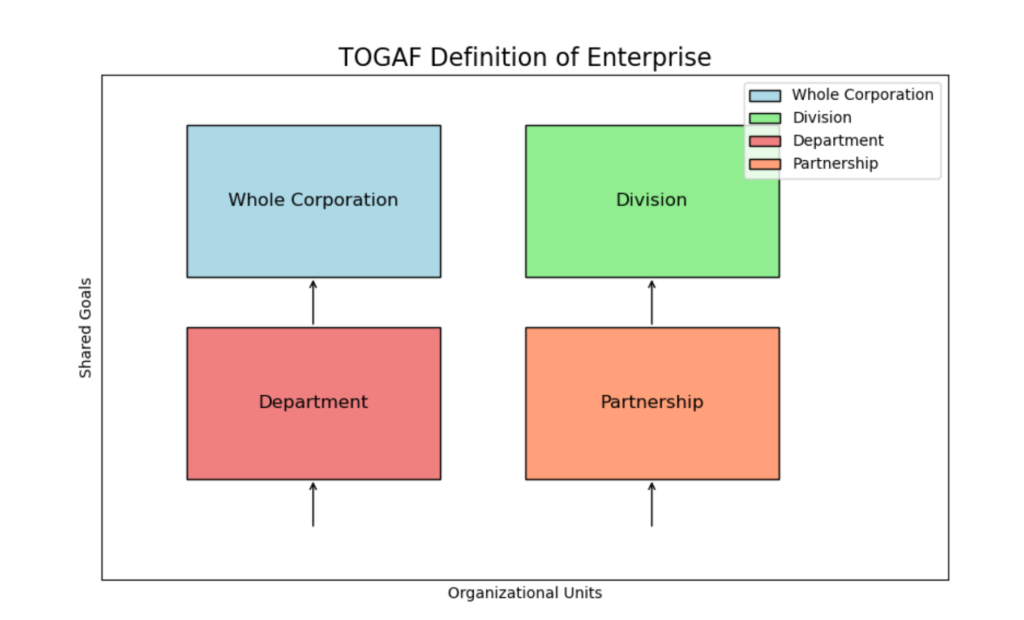-
The Purpose of Enterprise Architecture
- Posted on: June 2, 2025
- by: Anand Pandey
- 0 Comments
In enterprise architecture, clarity of scope is essential. TOGAF (The Open Group Architecture Framework) offers a flexible and inclusive definition of “enterprise” that helps architects align technology with business goals effectively.
🔍 What Does TOGAF Mean by “Enterprise”?
TOGAF defines an enterprise as:
“Any collection of organizations that has a common set of goals.”
This means an enterprise isn’t limited to a single company. It could be:
- A corporation
- A business unit or department
- A government agency
- A partnership between multiple organizations
The key is the shared purpose—not the organizational boundaries.
🎯 Why Define the Enterprise?
The purpose of defining the enterprise in TOGAF is to:
- Establish a clear architectural scope
- Align IT systems with strategic business objectives
- Identify relevant stakeholders and their concerns
- Ensure consistency across systems, processes, and governance
By clearly defining the enterprise, architects can focus on delivering value where it matters most.
✅ Real-World Example
Imagine you’re working on a digital platform for a public-private healthcare initiative. The platform involves:
- A government health department
- A private hospital network
- A third-party logistics provider for medical supplies
Even though these are separate organizations, they share a common goal: improving healthcare delivery. In TOGAF terms, they collectively form an enterprise for the purpose of this architecture.
🧩 Visualizing the TOGAF Enterprise Scope
Here’s a diagram that illustrates how different organizational units can be part of a single enterprise when they share common goals:

📝 Summary
Understanding the purpose of defining an enterprise in TOGAF is foundational to successful architecture work. It ensures that all efforts are aligned with shared goals, regardless of organizational boundaries. Whether you’re working within a single department or across multiple entities, TOGAF’s flexible definition helps you focus on delivering strategic value through architecture.
-
In TOGAF (The Open Group Architecture Framework), the term “Enterprise” has a specific and flexible meaning that goes beyond just a single company or organization.
🔍 TOGAF Definition of “Enterprise”
According to TOGAF:
“An enterprise is any collection of organizations that has a common set of goals.”
This could be:
- A whole corporation
- A division within a corporation
- A government agency
- A partnership of multiple organizations
- Even a department or a project team, depending on the context
The key idea is that the enterprise is defined by shared goals and objectives, not necessarily by legal or organizational boundaries.
🧠 Why This Matters in Architecture
In enterprise architecture, defining the scope of the enterprise is crucial because it determines:
- What systems and processes are included
- Who the stakeholders are
- What goals the architecture must support
✅ Example
Let’s say you work at Dell Technologies.
- If you’re designing architecture for Dell’s global e-commerce platform, your “enterprise” might be the entire Dell Digital division.
- If you’re focused only on the Cart & Checkout team, your enterprise might be just that specific product team.
- If Dell partners with a logistics company to streamline delivery, and you’re designing a shared system, the “enterprise” could include both organizations.
Here’s a visual diagram that illustrates the TOGAF concept of an Enterprise:

🔍 Diagram Explanation:
- Whole Corporation: The broadest scope, representing the entire organization.
- Division: A major business unit within the corporation.
- Department: A smaller, focused team or function within a division.
- Partnership: A collaboration between different organizations.
All of these are considered part of an “enterprise” in TOGAF as long as they share common goals.
🧩 Summary
Term Meaning in TOGAF Context Enterprise A group with shared goals (not just a company) Scope Defined by purpose, not legal structure Example A department, a business unit, or a multi-org partnership
Author Archives